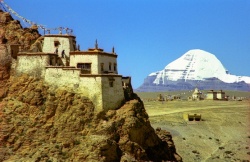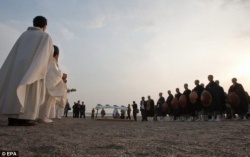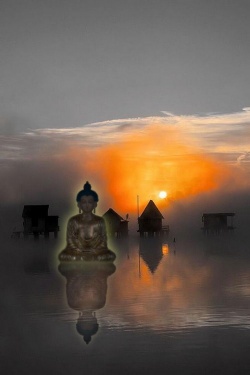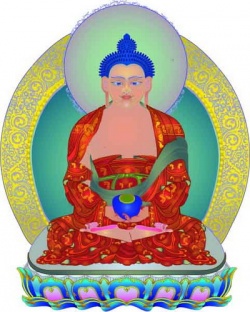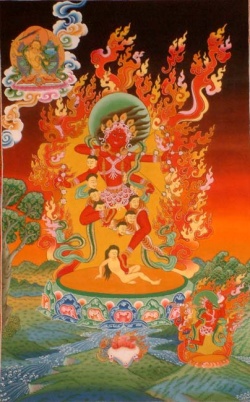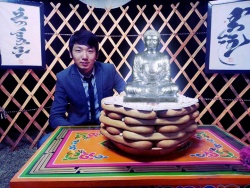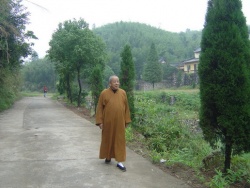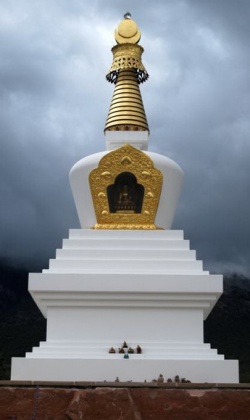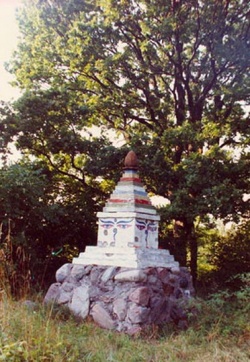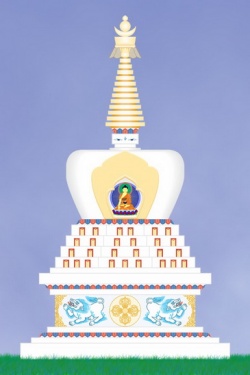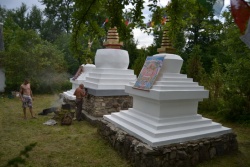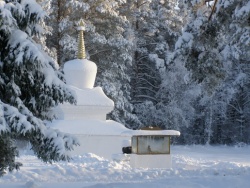Difference between revisions of "What is a Stupa?"
| Line 1: | Line 1: | ||
| − | + | <nomobile>{{DisplayImages|469|649|4216|1142|504|3896|3694|3187}}</nomobile> | |
<poem> | <poem> | ||
[[Stupas]] are the famous [[Buddhist]] sacral buildings, places of [[pilgrimage]] and the high reverence in the [[Buddhist]] [[world]] since the [[ancient]] times. | [[Stupas]] are the famous [[Buddhist]] sacral buildings, places of [[pilgrimage]] and the high reverence in the [[Buddhist]] [[world]] since the [[ancient]] times. | ||
| − | They are containing [[relics]] of [[Buddha Shakyamuni]], those of other [[Enlightened]] [[Buddhas]], powerful [[Buddhist scriptures]], [[mantras]] and [[jewels]]. Each [[element]] of these structures holds a [[symbolic]] meaning and has received appropriate consecrations from high [[Buddhist teachers]]. | + | They are containing [[relics]] of [[Buddha Shakyamuni]], those of other [[Enlightened]] [[Buddhas]], powerful [[Buddhist scriptures]], [[mantras]] and [[jewels]]. |
| + | |||
| + | Each [[element]] of these structures holds a [[symbolic]] meaning and has received appropriate consecrations from high [[Buddhist teachers]]. | ||
| + | |||
| + | It is believed [[Stupas]] or [[chaityas]] have been built already in pre-Buddhist {{Wiki|era}} in [[India]] as [[burial grounds]] to mark the remains of [[worldly]] rulers. | ||
| + | |||
| + | But after [[Buddha]] passed away into [[parinirvana]] his remains were [[Wikipedia:cremation|cremated]] and ashes divided and [[Wikipedia:burial|buried]] under 8 [[stupas]] and later two more. | ||
| − | + | In this way [[stupas]] turned into places of great veneration and [[pilgrimages]]. Later, in 3d century BCE the great [[emperor]] of [[Magadha]] [[Ashoka]] started [[to build]] thousands of [[Stupas]] all over the [[Indian]] subcontinent and {{Wiki|South Asia}}. | |
| + | |||
| + | It is said 84 thousand [[Stupas]] were built by [[Ashoka]] {{Wiki|edicts}} and guidance. He opened the original [[Stupas]] and distributed the remains between the newly built. As [[stupas]] spread in different {{Wiki|Asian}} countries, they acquired slight local features and are known as [[chortens]] in [[Tibet]] and [[pagodas]] in {{Wiki|East Asia}}. | ||
The shape of the [[stupa]] represents the [[Buddha]], crowned and sitting in [[meditation posture]] on a [[lion throne]]. His {{Wiki|crown}} is the top of the spire; his head is the square at the spire's base; his [[body]] is the [[vase]] shape; his {{Wiki|legs}} are the four steps of the lower terrace; and the base is his [[throne]]. | The shape of the [[stupa]] represents the [[Buddha]], crowned and sitting in [[meditation posture]] on a [[lion throne]]. His {{Wiki|crown}} is the top of the spire; his head is the square at the spire's base; his [[body]] is the [[vase]] shape; his {{Wiki|legs}} are the four steps of the lower terrace; and the base is his [[throne]]. | ||
| − | + | Each [[Stupa]] in the [[Tibetan tradition]] sits upon a square base called [[Lions Seat]]. | |
| + | |||
| + | Its four sides [[symbolize]] four qualities of the [[mind]], namely: [[Love]], [[Compassion]], [[Joy]] and [[Equanimity]]. | ||
| + | |||
| + | The base is usually filled with [[jewels]], [[Buddhist texts]] and [[mantras]], and other [[relics]] according to the specifics of this [[stupa]]. | ||
| + | |||
| + | On top of that is usually build five steps that represents the [[minds]] progression towards [[enlightenment]]. | ||
| + | |||
| + | Each step can be divided into two and refers to the ten levels of [[Bodhisattva]] realisation. Or depending on [[tradition]] there can be only three steps [[standing]] for the [[Buddha]], [[Dharma]] and [[Sangha]]. | ||
| + | |||
| + | Above the steps there is a rounded [[form]] build called [[Bumpa]]. It can contain a room for [[meditations]] in large [[stupas]], but in smaller [[stupas]] it is filled with more [[relics]] and [[precious]] texts and [[jewels]]. | ||
| + | |||
| + | It is very precisely described what exactly should be placed inside and how it should be crafted. | ||
| + | |||
| + | |||
| + | The first type of [[relics]] is called [[Dharma]] [[relics]] or Tsa Tsa. | ||
| + | |||
| + | These are many small clay [[stupa]] models. Inside of them are put various special [[mantras]] written on a paper and rolled into thin rolls. | ||
| − | + | Tsa Tsas can only be made by [[monks and nuns]] or [[lay people]] who have taken [[Buddhist]] [[refuge]] and who have taken eight basic [[Buddhist precepts]] for the day. | |
Other [[relics]] placed inside [[stupa]] have to be remnants of the [[Buddha’s body]] and robe. In our days for this [[cause]] often are used [[relics]] of later [[Enlightened]] [[Buddhist teachers]] as those of [[Guru Rinpoche]], [[Tilopa]], [[Marpa]] and [[Karmapas]]. | Other [[relics]] placed inside [[stupa]] have to be remnants of the [[Buddha’s body]] and robe. In our days for this [[cause]] often are used [[relics]] of later [[Enlightened]] [[Buddhist teachers]] as those of [[Guru Rinpoche]], [[Tilopa]], [[Marpa]] and [[Karmapas]]. | ||
The final [[relic]] to be placed in a [[Stupa]] is the [[Mantra]] [[Relic]]. It includes the eighty four thousand [[teachings of the Buddha]] along with the commentaries on his teachings by many of the later [[enlightened]] [[teachers]]. | The final [[relic]] to be placed in a [[Stupa]] is the [[Mantra]] [[Relic]]. It includes the eighty four thousand [[teachings of the Buddha]] along with the commentaries on his teachings by many of the later [[enlightened]] [[teachers]]. | ||
| + | |||
Through the very centre of [[stupa]] goes a central axis, called Sog [[Shing]] in [[Tibetan]], meaning “[[Life]] [[Tree]]”. Usually it is made from a [[Sandalwood]] or {{Wiki|Juniper}} but if those are not accessible, can be used any [[tree]] that doesn’t bear {{Wiki|poisonous}} [[fruits]]. | Through the very centre of [[stupa]] goes a central axis, called Sog [[Shing]] in [[Tibetan]], meaning “[[Life]] [[Tree]]”. Usually it is made from a [[Sandalwood]] or {{Wiki|Juniper}} but if those are not accessible, can be used any [[tree]] that doesn’t bear {{Wiki|poisonous}} [[fruits]]. | ||
| Line 24: | Line 50: | ||
[[Birth]] [[Stupa]] - The four steps of the basis of this [[stupa]] is circular, and it is decorated with lotus-petal designs. Occasionally, seven heaped [[lotus]] steps are [[constructed]]. These refer to the seven first steps of the [[Buddha]]. Example – [[Lumbini]] [[Stupa]]. | [[Birth]] [[Stupa]] - The four steps of the basis of this [[stupa]] is circular, and it is decorated with lotus-petal designs. Occasionally, seven heaped [[lotus]] steps are [[constructed]]. These refer to the seven first steps of the [[Buddha]]. Example – [[Lumbini]] [[Stupa]]. | ||
| − | [[Enlightenment Stupa]] - Also known as the [[Stupa of the Conquest of Mara]]. This [[stupa]] [[symbolizes]] the 35-year-old [[Buddha's]] [[attainment]] of [[enlightenment]] under the [[bodhi tree]] in [[Bodh Gaya]], where he conquered [[worldly]] temptations and attacks [[manifesting]] in the [[form]] of [[Mara]]. | + | |
| + | [[Enlightenment Stupa]] - Also known as the [[Stupa of the Conquest of Mara]]. | ||
| + | |||
| + | This [[stupa]] [[symbolizes]] the 35-year-old [[Buddha's]] [[attainment]] of [[enlightenment]] under the [[bodhi tree]] in [[Bodh Gaya]], where he conquered [[worldly]] temptations and attacks [[manifesting]] in the [[form]] of [[Mara]]. | ||
| + | |||
[[Stupa of Many Doors]] - Also known as the [[Stupa of Many Gates]]. After the [[Buddha]] reached his [[enlightenment]], he [[taught]] his first students in a [[deer-park]] near [[Sarnath]]. The multiple doors on each side of the steps represent the first teachings: the [[Four Noble Truths]], the [[Six Perfections]], the [[Noble Eightfold Path]] and the [[Twelve Links]] in the Chain of [[Dependent Origination]]. Example – [[stupa]] at [[Sarnath]] ([[Varanasi]]). | [[Stupa of Many Doors]] - Also known as the [[Stupa of Many Gates]]. After the [[Buddha]] reached his [[enlightenment]], he [[taught]] his first students in a [[deer-park]] near [[Sarnath]]. The multiple doors on each side of the steps represent the first teachings: the [[Four Noble Truths]], the [[Six Perfections]], the [[Noble Eightfold Path]] and the [[Twelve Links]] in the Chain of [[Dependent Origination]]. Example – [[stupa]] at [[Sarnath]] ([[Varanasi]]). | ||
| − | [[Stupa of Descent]] from [[Tushita heaven]] - At 42 years of age, [[Buddha]] spent one rainy seasons [[retreat]] in [[Tushita Heaven]], where his mother had taken [[rebirth]]. In [[order]] to repay her [[kindness]] he [[taught]] the [[dharma]] to her [[reincarnation]]. Local inhabitants built a [[stupa]] like this in Samkashya in [[order]] to commemorate this event. This [[stupa]] is characterized by having a central projection at each side containing a triple ladder or steps. | + | |
| + | [[Stupa of Descent]] from [[Tushita heaven]] - At 42 years of age, [[Buddha]] spent one rainy seasons [[retreat]] in [[Tushita Heaven]], where his mother had taken [[rebirth]]. In [[order]] to repay her [[kindness]] he [[taught]] the [[dharma]] to her [[reincarnation]]. | ||
| + | |||
| + | Local inhabitants built a [[stupa]] like this in Samkashya in [[order]] to commemorate this event. This [[stupa]] is characterized by having a central projection at each side containing a triple ladder or steps. | ||
| + | |||
[[Stupa of Great Miracles]] - This [[stupa]] refers to various [[miracles]] performed by the [[Buddha]] when he was 50 years old. Legend tells that he overpowered [[maras]] and {{Wiki|heretics}} by engaging them in [[intellectual]] arguments and also by performing [[miracles]]. This [[stupa]] was built by the Lichavi {{Wiki|kingdom}} to commemorate the event. | [[Stupa of Great Miracles]] - This [[stupa]] refers to various [[miracles]] performed by the [[Buddha]] when he was 50 years old. Legend tells that he overpowered [[maras]] and {{Wiki|heretics}} by engaging them in [[intellectual]] arguments and also by performing [[miracles]]. This [[stupa]] was built by the Lichavi {{Wiki|kingdom}} to commemorate the event. | ||
| + | |||
[[Stupa of Reconciliation]] - This [[stupa]] commemorates the [[Buddha's]] resolution of a dispute among the [[sangha]]. A [[stupa]] in this design was built in the {{Wiki|kingdom}} of [[Magadha]], where the reconciliation occurred. It has four octagonal steps with {{Wiki|equal}} sides. | [[Stupa of Reconciliation]] - This [[stupa]] commemorates the [[Buddha's]] resolution of a dispute among the [[sangha]]. A [[stupa]] in this design was built in the {{Wiki|kingdom}} of [[Magadha]], where the reconciliation occurred. It has four octagonal steps with {{Wiki|equal}} sides. | ||
| + | |||
[[Stupa of Complete Victory]] - This [[stupa]] commemorates [[Buddha's]] successful prolonging of his [[life]] by three months. It has only three steps, which are circular and unadorned. | [[Stupa of Complete Victory]] - This [[stupa]] commemorates [[Buddha's]] successful prolonging of his [[life]] by three months. It has only three steps, which are circular and unadorned. | ||
| + | |||
[[Stupa of Nirvana]] - This [[stupa]] refers to the [[death]] of the [[Buddha]], when he was 80 years old. It [[symbolizes]] the [[Buddha's]] complete [[absorption]] into the [[highest state of mind]]. It is bell-shaped and usually not ornamented. | [[Stupa of Nirvana]] - This [[stupa]] refers to the [[death]] of the [[Buddha]], when he was 80 years old. It [[symbolizes]] the [[Buddha's]] complete [[absorption]] into the [[highest state of mind]]. It is bell-shaped and usually not ornamented. | ||
| + | |||
The 9th type of [[stupas]] is [[Kalachakra stupa]]. It is not directly connected with events in [[Buddha’s]] [[life]], but with the [[symbolism]] of [[Kalachakra tantra]], and is created to {{Wiki|protect}} against negative energies. | The 9th type of [[stupas]] is [[Kalachakra stupa]]. It is not directly connected with events in [[Buddha’s]] [[life]], but with the [[symbolism]] of [[Kalachakra tantra]], and is created to {{Wiki|protect}} against negative energies. | ||
| − | The most usual [[spiritual practice]] connected with [[stupas]] is circumambulation of [[stupa]] i.e. walking around the [[stupa]] in a {{Wiki|clockwise}} [[direction]]. [[Stupas]] radiate around them a large [[energy]] field of [[enlightened]] energies. It can bring countless Buddha-blessings, deep [[purification]] and countless other benefits. The same is true for taking part in the building of [[stupas]]. [[Stupa]] [[symbolizes]] [[Buddha]] himself with all effects and veneration to the [[Buddhas]] presence. Also widespread [[practice]] is [[prostrations]] to [[Stupa]]. | + | |
| + | The most usual [[spiritual practice]] connected with [[stupas]] is circumambulation of [[stupa]] i.e. walking around the [[stupa]] in a {{Wiki|clockwise}} [[direction]]. | ||
| + | |||
| + | [[Stupas]] radiate around them a large [[energy]] field of [[enlightened]] energies. | ||
| + | |||
| + | It can bring countless [[Buddha]]-blessings, deep [[purification]] and countless other benefits. | ||
| + | |||
| + | The same is true for taking part in the building of [[stupas]]. | ||
| + | |||
| + | [[Stupa]] [[symbolizes]] [[Buddha]] himself with all effects and veneration to the [[Buddhas]] presence. Also widespread [[practice]] is [[prostrations]] to [[Stupa]]. | ||
</poem> | </poem> | ||
{{R}} | {{R}} | ||
| Line 49: | Line 96: | ||
[[File:Stupa-001.jpg|thumb|250px|]] | [[File:Stupa-001.jpg|thumb|250px|]] | ||
<poem> | <poem> | ||
| − | A [[stupa]] is a [[symbol | + | A [[stupa]] is a [[symbol of enlightenment]] and is one of the most [[ancient]] icons of [[Buddhist art]]. [[Stupas]] are also the oldest and most prevalent [[forms]] of [[Buddhist architecture]]. |
| + | |||
| + | More than just [[being]] examples of [[art]] and [[architecture]], these {{Wiki|holy}} monuments were designed with deep [[symbolism]] and [[sacred]] geometry. Filled with [[Buddhist]] [[relics]], and other {{Wiki|holy}} [[objects]], [[stupas]] [[emanate]] [[blessings]] and [[peace]]. | ||
| + | |||
| + | A [[stupa]] is the most [[sacred]] monument found in all of the [[ancient]] [[Buddhist]] countries. Unique amongst all [[forms]] of [[sacred]] [[architecture]], it is the quintessential [[symbol]] of [[enlightenment]]. | ||
| + | |||
| + | [[Stupas]] are filled with [[sacred]] images, [[mantras]] and the [[relics]] of {{Wiki|holy}} [[beings]]. The foundation, {{Wiki|symmetry}}, orientation and contents of the [[stupa]] create incredible [[power]] to those who even look upon it. It has the potential to transcend the limitations of [[language]] to activate [[enlightened]] [[knowledge]]. | ||
| − | |||
“A [[stupa]] is a place where all the [[Buddhas]] are abiding. Those [[beings]] who don’t have the [[karma]] actually to see [[Buddha]] need the {{Wiki|holy}} [[objects]] of [[body]], [[speech]] and [[mind]] - [[statues]], [[scriptures]], [[stupas]] - as a field for accumulating [[merit]].” - [[Guhyasamaja]] [[Root]] Text | “A [[stupa]] is a place where all the [[Buddhas]] are abiding. Those [[beings]] who don’t have the [[karma]] actually to see [[Buddha]] need the {{Wiki|holy}} [[objects]] of [[body]], [[speech]] and [[mind]] - [[statues]], [[scriptures]], [[stupas]] - as a field for accumulating [[merit]].” - [[Guhyasamaja]] [[Root]] Text | ||
| Line 59: | Line 111: | ||
The various components of a [[stupa]] represent the following: | The various components of a [[stupa]] represent the following: | ||
| − | + | 1. The basic platform that “holds the [[earth]]” [[symbolizes]] the ten [[virtues]] of: | |
[[Body]]: | [[Body]]: | ||
| + | |||
| + | |||
* Protecting [[life]] | * Protecting [[life]] | ||
* Practicing [[generosity]] | * Practicing [[generosity]] | ||
| Line 67: | Line 121: | ||
{{Wiki|Speech}}: | {{Wiki|Speech}}: | ||
| + | |||
| + | |||
* Telling the [[truth]] | * Telling the [[truth]] | ||
* Reconciling others | * Reconciling others | ||
| Line 72: | Line 128: | ||
* {{Wiki|Speaking}} sensibly and meaningfully | * {{Wiki|Speaking}} sensibly and meaningfully | ||
[[File:Stuupa matsirannas.jpg|thumb|250px|]] | [[File:Stuupa matsirannas.jpg|thumb|250px|]] | ||
| + | |||
| + | |||
[[Mind]]: | [[Mind]]: | ||
| + | |||
| + | |||
* Practicing [[contentment]] | * Practicing [[contentment]] | ||
* [[Being]] {{Wiki|altruistic}} | * [[Being]] {{Wiki|altruistic}} | ||
* Having [[faith]] in [[right views]] (which are the correct foundation for [[liberation]]) | * Having [[faith]] in [[right views]] (which are the correct foundation for [[liberation]]) | ||
| + | |||
2. The three steps above [[symbolize]] the [[three refuges]] one holds on to: | 2. The three steps above [[symbolize]] the [[three refuges]] one holds on to: | ||
| + | |||
| + | |||
* [[Buddha]] | * [[Buddha]] | ||
* [[Dharma]] | * [[Dharma]] | ||
* [[Sangha]] | * [[Sangha]] | ||
| + | |||
3. The [[lion throne]] [[symbolizes]] {{Wiki|superiority}} over the whole [[universe]] and, in particular, the [[four fearlessnesses]], which are a result of the four [[knowledges]]: | 3. The [[lion throne]] [[symbolizes]] {{Wiki|superiority}} over the whole [[universe]] and, in particular, the [[four fearlessnesses]], which are a result of the four [[knowledges]]: | ||
| + | |||
| + | |||
* [[Knowledge]] that all factors of [[existence]] are understood | * [[Knowledge]] that all factors of [[existence]] are understood | ||
* [[Knowledge]] that the [[obstacles]] are correctly known and the way to stop them can be [[taught]] to others | * [[Knowledge]] that the [[obstacles]] are correctly known and the way to stop them can be [[taught]] to others | ||
| Line 89: | Line 155: | ||
4. The [[treasure vase]] [[symbolizes]] the eight [[precious]] {{Wiki|royal}} [[objects]] (eight [[noble]] riches) | 4. The [[treasure vase]] [[symbolizes]] the eight [[precious]] {{Wiki|royal}} [[objects]] (eight [[noble]] riches) | ||
| + | |||
| + | |||
5. The small and the big [[lotuses]] [[symbolize]] the six [[transcendental]] [[virtues]] ([[six perfections]]): | 5. The small and the big [[lotuses]] [[symbolize]] the six [[transcendental]] [[virtues]] ([[six perfections]]): | ||
| + | |||
| + | |||
* [[Generosity]] | * [[Generosity]] | ||
* [[Morality]] ([[ethics]]) | * [[Morality]] ([[ethics]]) | ||
| Line 97: | Line 167: | ||
* [[Meditation]] | * [[Meditation]] | ||
* [[Wisdom]] | * [[Wisdom]] | ||
| + | |||
| + | |||
[[File:Osel-stupa.jpg|thumb|250px|]] | [[File:Osel-stupa.jpg|thumb|250px|]] | ||
6. The four corners of the basic [[throne]] [[symbolize]] the [[four immeasurables]]: | 6. The four corners of the basic [[throne]] [[symbolize]] the [[four immeasurables]]: | ||
| + | |||
| + | |||
* [[Immeasurable]] [[love]] | * [[Immeasurable]] [[love]] | ||
* [[Immeasurable]] [[compassion]] | * [[Immeasurable]] [[compassion]] | ||
* [[Immeasurable]] [[joy]] | * [[Immeasurable]] [[joy]] | ||
* [[Immeasurable]] [[equanimity]] | * [[Immeasurable]] [[equanimity]] | ||
| + | |||
7. The first step [[symbolizes]] the [[four mindfulnesses]]: | 7. The first step [[symbolizes]] the [[four mindfulnesses]]: | ||
| + | |||
| + | |||
* [[Mindfulness]] of the [[body]] | * [[Mindfulness]] of the [[body]] | ||
* [[Mindfulness]] of [[feelings]] | * [[Mindfulness]] of [[feelings]] | ||
* [[Mindfulness]] of the [[non-substantiality]] of [[thoughts]] | * [[Mindfulness]] of the [[non-substantiality]] of [[thoughts]] | ||
* [[Mindfulness]] of the [[condition]] of [[existence]] ([[dharmas]]) | * [[Mindfulness]] of the [[condition]] of [[existence]] ([[dharmas]]) | ||
| + | |||
| + | |||
8. The second step [[symbolizes]] the four {{Wiki|perfect}} efforts ([[sammapadhana]]): | 8. The second step [[symbolizes]] the four {{Wiki|perfect}} efforts ([[sammapadhana]]): | ||
| + | |||
| + | |||
* Striving to preserve [[existing]] [[favourable]] [[conditions]] | * Striving to preserve [[existing]] [[favourable]] [[conditions]] | ||
* Striving to produce such [[conditions]] not yet [[existing]] | * Striving to produce such [[conditions]] not yet [[existing]] | ||
| Line 116: | Line 197: | ||
* Striving to make it impossible for such [[conditions]] to arise | * Striving to make it impossible for such [[conditions]] to arise | ||
[[File:948.JPG|thumb|250px|]] | [[File:948.JPG|thumb|250px|]] | ||
| + | |||
| + | |||
9. The third step [[symbolizes]] the four miraculous feats ([[riddhipada]]): | 9. The third step [[symbolizes]] the four miraculous feats ([[riddhipada]]): | ||
| + | |||
| + | |||
* [[Intention]] | * [[Intention]] | ||
* [[Thought]] | * [[Thought]] | ||
| Line 123: | Line 208: | ||
10. The fourth step [[symbolizes]] the [[five powers]] ([[indriya]]): | 10. The fourth step [[symbolizes]] the [[five powers]] ([[indriya]]): | ||
| + | |||
| + | |||
* The {{Wiki|faculty}} of [[faith]] | * The {{Wiki|faculty}} of [[faith]] | ||
* The {{Wiki|faculty}} of [[energy]] | * The {{Wiki|faculty}} of [[energy]] | ||
| Line 128: | Line 215: | ||
* The {{Wiki|faculty}} of [[concentration]] | * The {{Wiki|faculty}} of [[concentration]] | ||
* The {{Wiki|faculty}} of [[knowledge]] | * The {{Wiki|faculty}} of [[knowledge]] | ||
| + | |||
| + | |||
11. The [[unchanging]] base that supports the [[vase]] [[symbolizes]] the [[five forces]] ([[bala]]): | 11. The [[unchanging]] base that supports the [[vase]] [[symbolizes]] the [[five forces]] ([[bala]]): | ||
| + | |||
| + | |||
* The force of [[faith]] | * The force of [[faith]] | ||
* The force of [[energy]] | * The force of [[energy]] | ||
| Line 136: | Line 227: | ||
* The force of [[knowledge]] | * The force of [[knowledge]] | ||
[[File:Veltsa talvel .JPG|thumb|250px|]] | [[File:Veltsa talvel .JPG|thumb|250px|]] | ||
| + | |||
| + | |||
| + | |||
12. The [[vase]] in its particularities [[symbolizes]] the [[seven branches]] of [[awakening]] ([[bodhyanga]]): | 12. The [[vase]] in its particularities [[symbolizes]] the [[seven branches]] of [[awakening]] ([[bodhyanga]]): | ||
| + | |||
| + | |||
* Total [[memory]] (or [[past lives]]) | * Total [[memory]] (or [[past lives]]) | ||
* [[Perfect knowledge]] of all [[dharmas]] | * [[Perfect knowledge]] of all [[dharmas]] | ||
| Line 144: | Line 240: | ||
* [[Concentration]] | * [[Concentration]] | ||
* [[Equanimity]] | * [[Equanimity]] | ||
| + | |||
| + | |||
13. The “tre” (“[[Harmika]]” above the [[vase]]) and its reverse [[symbolize]] the [[noble]] [[eightfold path]]: | 13. The “tre” (“[[Harmika]]” above the [[vase]]) and its reverse [[symbolize]] the [[noble]] [[eightfold path]]: | ||
| + | |||
* [[Perfect view]] | * [[Perfect view]] | ||
| + | |||
* Perfect [[understanding]] | * Perfect [[understanding]] | ||
* Perfect [[speech]] | * Perfect [[speech]] | ||
| Line 154: | Line 254: | ||
* Perfect [[attention]] | * Perfect [[attention]] | ||
* Perfect [[concentration]] | * Perfect [[concentration]] | ||
| + | |||
| + | |||
14. The [[tree]] of [[life]] (sog [[shing]]) [[symbolizes]] the ten [[knowledges]] of [[phenomena]]: | 14. The [[tree]] of [[life]] (sog [[shing]]) [[symbolizes]] the ten [[knowledges]] of [[phenomena]]: | ||
| + | |||
| + | |||
* [[Mind]] (the [[thoughts]] of others) | * [[Mind]] (the [[thoughts]] of others) | ||
* [[Interdependent]] links | * [[Interdependent]] links | ||
| Line 165: | Line 269: | ||
* Things that lead to {{Wiki|despair}} | * Things that lead to {{Wiki|despair}} | ||
* The non-production of things | * The non-production of things | ||
| + | |||
15. The thirteen rings [[symbolize]]: | 15. The thirteen rings [[symbolize]]: | ||
| + | |||
* The [[ten powers]] (or alternatively, the ten [[bodhisattva]] [[bhumis]]) | * The [[ten powers]] (or alternatively, the ten [[bodhisattva]] [[bhumis]]) | ||
| + | |||
* The three [[essential]] remembrances | * The three [[essential]] remembrances | ||
</poem> | </poem> | ||
Revision as of 08:08, 26 October 2015
Stupas are the famous Buddhist sacral buildings, places of pilgrimage and the high reverence in the Buddhist world since the ancient times.
They are containing relics of Buddha Shakyamuni, those of other Enlightened Buddhas, powerful Buddhist scriptures, mantras and jewels.
Each element of these structures holds a symbolic meaning and has received appropriate consecrations from high Buddhist teachers.
It is believed Stupas or chaityas have been built already in pre-Buddhist era in India as burial grounds to mark the remains of worldly rulers.
But after Buddha passed away into parinirvana his remains were cremated and ashes divided and buried under 8 stupas and later two more.
In this way stupas turned into places of great veneration and pilgrimages. Later, in 3d century BCE the great emperor of Magadha Ashoka started to build thousands of Stupas all over the Indian subcontinent and South Asia.
It is said 84 thousand Stupas were built by Ashoka edicts and guidance. He opened the original Stupas and distributed the remains between the newly built. As stupas spread in different Asian countries, they acquired slight local features and are known as chortens in Tibet and pagodas in East Asia.
The shape of the stupa represents the Buddha, crowned and sitting in meditation posture on a lion throne. His crown is the top of the spire; his head is the square at the spire's base; his body is the vase shape; his legs are the four steps of the lower terrace; and the base is his throne.
Each Stupa in the Tibetan tradition sits upon a square base called Lions Seat.
Its four sides symbolize four qualities of the mind, namely: Love, Compassion, Joy and Equanimity.
The base is usually filled with jewels, Buddhist texts and mantras, and other relics according to the specifics of this stupa.
On top of that is usually build five steps that represents the minds progression towards enlightenment.
Each step can be divided into two and refers to the ten levels of Bodhisattva realisation. Or depending on tradition there can be only three steps standing for the Buddha, Dharma and Sangha.
Above the steps there is a rounded form build called Bumpa. It can contain a room for meditations in large stupas, but in smaller stupas it is filled with more relics and precious texts and jewels.
It is very precisely described what exactly should be placed inside and how it should be crafted.
The first type of relics is called Dharma relics or Tsa Tsa.
These are many small clay stupa models. Inside of them are put various special mantras written on a paper and rolled into thin rolls.
Tsa Tsas can only be made by monks and nuns or lay people who have taken Buddhist refuge and who have taken eight basic Buddhist precepts for the day.
Other relics placed inside stupa have to be remnants of the Buddha’s body and robe. In our days for this cause often are used relics of later Enlightened Buddhist teachers as those of Guru Rinpoche, Tilopa, Marpa and Karmapas.
The final relic to be placed in a Stupa is the Mantra Relic. It includes the eighty four thousand teachings of the Buddha along with the commentaries on his teachings by many of the later enlightened teachers.
Through the very centre of stupa goes a central axis, called Sog Shing in Tibetan, meaning “Life Tree”. Usually it is made from a Sandalwood or Juniper but if those are not accessible, can be used any tree that doesn’t bear poisonous fruits.
Eight great stupasIn Tibetan Buddhism there are 8 kinds of different stupas being built commemorating significant events during Buddha’s life:
Birth Stupa - The four steps of the basis of this stupa is circular, and it is decorated with lotus-petal designs. Occasionally, seven heaped lotus steps are constructed. These refer to the seven first steps of the Buddha. Example – Lumbini Stupa.
Enlightenment Stupa - Also known as the Stupa of the Conquest of Mara.
This stupa symbolizes the 35-year-old Buddha's attainment of enlightenment under the bodhi tree in Bodh Gaya, where he conquered worldly temptations and attacks manifesting in the form of Mara.
Stupa of Many Doors - Also known as the Stupa of Many Gates. After the Buddha reached his enlightenment, he taught his first students in a deer-park near Sarnath. The multiple doors on each side of the steps represent the first teachings: the Four Noble Truths, the Six Perfections, the Noble Eightfold Path and the Twelve Links in the Chain of Dependent Origination. Example – stupa at Sarnath (Varanasi).
Stupa of Descent from Tushita heaven - At 42 years of age, Buddha spent one rainy seasons retreat in Tushita Heaven, where his mother had taken rebirth. In order to repay her kindness he taught the dharma to her reincarnation.
Local inhabitants built a stupa like this in Samkashya in order to commemorate this event. This stupa is characterized by having a central projection at each side containing a triple ladder or steps.
Stupa of Great Miracles - This stupa refers to various miracles performed by the Buddha when he was 50 years old. Legend tells that he overpowered maras and heretics by engaging them in intellectual arguments and also by performing miracles. This stupa was built by the Lichavi kingdom to commemorate the event.
Stupa of Reconciliation - This stupa commemorates the Buddha's resolution of a dispute among the sangha. A stupa in this design was built in the kingdom of Magadha, where the reconciliation occurred. It has four octagonal steps with equal sides.
Stupa of Complete Victory - This stupa commemorates Buddha's successful prolonging of his life by three months. It has only three steps, which are circular and unadorned.
Stupa of Nirvana - This stupa refers to the death of the Buddha, when he was 80 years old. It symbolizes the Buddha's complete absorption into the highest state of mind. It is bell-shaped and usually not ornamented.
The 9th type of stupas is Kalachakra stupa. It is not directly connected with events in Buddha’s life, but with the symbolism of Kalachakra tantra, and is created to protect against negative energies.
The most usual spiritual practice connected with stupas is circumambulation of stupa i.e. walking around the stupa in a clockwise direction.
Stupas radiate around them a large energy field of enlightened energies.
It can bring countless Buddha-blessings, deep purification and countless other benefits.
The same is true for taking part in the building of stupas.
Stupa symbolizes Buddha himself with all effects and veneration to the Buddhas presence. Also widespread practice is prostrations to Stupa.
Source
A stupa is a symbol of enlightenment and is one of the most ancient icons of Buddhist art. Stupas are also the oldest and most prevalent forms of Buddhist architecture.
More than just being examples of art and architecture, these holy monuments were designed with deep symbolism and sacred geometry. Filled with Buddhist relics, and other holy objects, stupas emanate blessings and peace.
A stupa is the most sacred monument found in all of the ancient Buddhist countries. Unique amongst all forms of sacred architecture, it is the quintessential symbol of enlightenment.
Stupas are filled with sacred images, mantras and the relics of holy beings. The foundation, symmetry, orientation and contents of the stupa create incredible power to those who even look upon it. It has the potential to transcend the limitations of language to activate enlightened knowledge.
“A stupa is a place where all the Buddhas are abiding. Those beings who don’t have the karma actually to see Buddha need the holy objects of body, speech and mind - statues, scriptures, stupas - as a field for accumulating merit.” - Guhyasamaja Root Text
The Symbolic Meaning of Stupas
The various components of a stupa represent the following:
1. The basic platform that “holds the earth” symbolizes the ten virtues of:
Body:
- Protecting life
- Practicing generosity
- Keeping pure morality
- Telling the truth
- Reconciling others
- Speaking in a quiet and gentle way
- Speaking sensibly and meaningfully
Mind:
- Practicing contentment
- Being altruistic
- Having faith in right views (which are the correct foundation for liberation)
2. The three steps above symbolize the three refuges one holds on to:
3. The lion throne symbolizes superiority over the whole universe and, in particular, the four fearlessnesses, which are a result of the four knowledges:
- Knowledge that all factors of existence are understood
- Knowledge that the obstacles are correctly known and the way to stop them can be taught to others
- Knowledge that the path of renunciation, through which all the virtuous qualities are obtained, has in fact been accomplished
- Knowledge that all corruption has been brought to an end
4. The treasure vase symbolizes the eight precious royal objects (eight noble riches)
5. The small and the big lotuses symbolize the six transcendental virtues (six perfections):
- Generosity
- Morality (ethics)
- Patience
- Energy (enthusiastic perseverance)
- Meditation
- Wisdom
6. The four corners of the basic throne symbolize the four immeasurables:
7. The first step symbolizes the four mindfulnesses:
- Mindfulness of the body
- Mindfulness of feelings
- Mindfulness of the non-substantiality of thoughts
- Mindfulness of the condition of existence (dharmas)
8. The second step symbolizes the four perfect efforts (sammapadhana):
- Striving to preserve existing favourable conditions
- Striving to produce such conditions not yet existing
- Striving to ward off existing unfavorable conditions
- Striving to make it impossible for such conditions to arise
9. The third step symbolizes the four miraculous feats (riddhipada):
10. The fourth step symbolizes the five powers (indriya):
- The faculty of faith
- The faculty of energy
- The faculty of attention
- The faculty of concentration
- The faculty of knowledge
11. The unchanging base that supports the vase symbolizes the five forces (bala):
- The force of faith
- The force of energy
- The force of attention
- The force of concentration
- The force of knowledge
12. The vase in its particularities symbolizes the seven branches of awakening (bodhyanga):
- Total memory (or past lives)
- Perfect knowledge of all dharmas
- Diligence
- Ecstasy
- Perfect mastery of all disciplines
- Concentration
- Equanimity
13. The “tre” (“Harmika” above the vase) and its reverse symbolize the noble eightfold path:
- Perfect understanding
- Perfect speech
- Perfect action
- Perfect living
- Perfect effort
- Perfect attention
- Perfect concentration
14. The tree of life (sog shing) symbolizes the ten knowledges of phenomena:
- Mind (the thoughts of others)
- Interdependent links
- Empirical knowledge
- Suffering
- The origin of suffering
- The cessation of suffering
- The path leading to the cessation of suffering
- Things that lead to despair
- The non-production of things
15. The thirteen rings symbolize:
- The ten powers (or alternatively, the ten bodhisattva bhumis)
- The three essential remembrances
